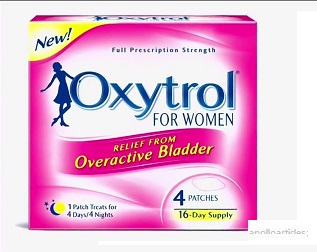Oxytrol (Oxybutynin) Canada
Description
Oxytrol is an innovative medication that stimulates a potent impact on the bladder and urinary tract. The active ingredient of the remedy, Oxybutynin, works reducing the muscle spasm that occurred in the specified areas. The treatment can be used for several disorders, including boosted nighttime urinations, frequent urination and other signs of overactive bladder. Additionally, the medication can be taken for other instances, not listed in the safety guide. Ask your healthcare specialist about off-label drug use.
Recommendations
 Oxytrol is available in the form of skin patches that should be used right as prescribed by a healthcare provider. A patient should take the remedy in the exact dose and for a complete length of the therapy adjusted. Following the safety directions is halfway to a successful and effective therapy.
Oxytrol is available in the form of skin patches that should be used right as prescribed by a healthcare provider. A patient should take the remedy in the exact dose and for a complete length of the therapy adjusted. Following the safety directions is halfway to a successful and effective therapy.
Oxytrol skin patches should be used in clean and dry zones only, on the buttock, stomach or hip. It is prohibited to apply it to the areas of irritated, oily or damaged skin. Press the patch into the necessary place with your fingers. The medication should stay on the same place for over 3 days. Your doctor will advise you to change Oxytrol patch approximately 2 times a day. The medication should not be put on the same place each time. Use different areas in order to avoid the medication misuse or overuse. Contact your healthcare provider if you have any questions or problems using the treatment.
Precautions and Contraindications
Due to the powerful impact Oxytrol triggers in the body, it should be administered with exceptional caution. Thus, consult your physician before the medication intake in order to prevent possible side effects related to Oxytrol contraindications and interactions. Do not start the therapy if you are sensitive to its active ingredients or other components. Additionally, patients with decreased urination, its impairments, uncontrolled or untreated narrow-angle glaucoma, stomach blockage and other health complications are contraindicated for the medication intake. Pregnant and breastfeeding women should not take Oxytrol in terms of safety. Additionally, a patient should provide the doctor with detailed information about other health impairments, diseases and abnormalities he/she has, including enlarged prostate, kidney or liver issues, glaucoma, intestinal complications, stomach disorders, myasthenia gravis and others.
Drug Interactions
Serious drug interactions may occur if Oxytrol is combined with other pharmaceuticals without doctor’s permission. The medication interactions may result in decreased effect of both drugs or aggravating side effects and new symptoms. Warn your doctor about all the drugs, herbal products and other pharmaceutical supplements you are using to prevent complications. Never combine Oxytrol with similar urinary tract or bladder drugs, bronchodilators, osteoporosis remedies, stomach ulcers drugs, treatment for Parkinson’s disease, medications for irritable bowel syndrome and others.
Side Effects
Call your doctor the moment Oxytrol administration stimulated the appearance of bothersome side effects, such as confusion, uneven heartbeat, hallucinations, urination complications, constipation, symptoms of dehydration, angina, vomiting, etc. Seek emergency medical help if the drug intake resulted in severe allergic reactions. Diarrhea, vision disorders, dizziness and drowsiness and nausea may also occur after Oxytrol use.

